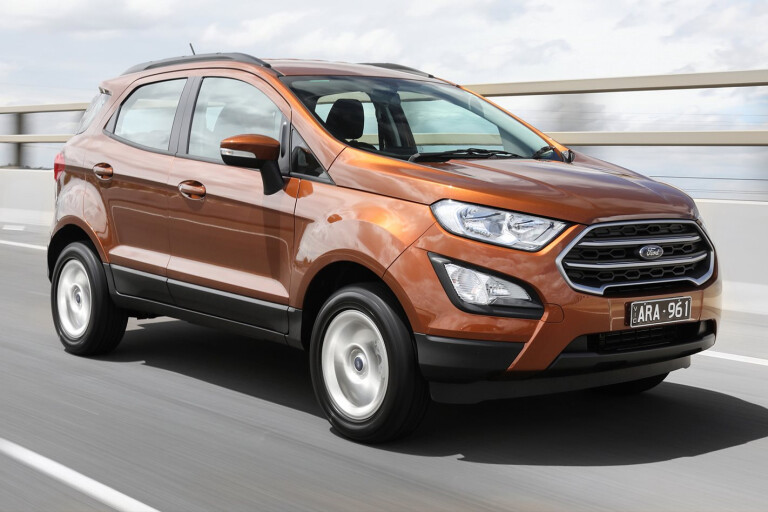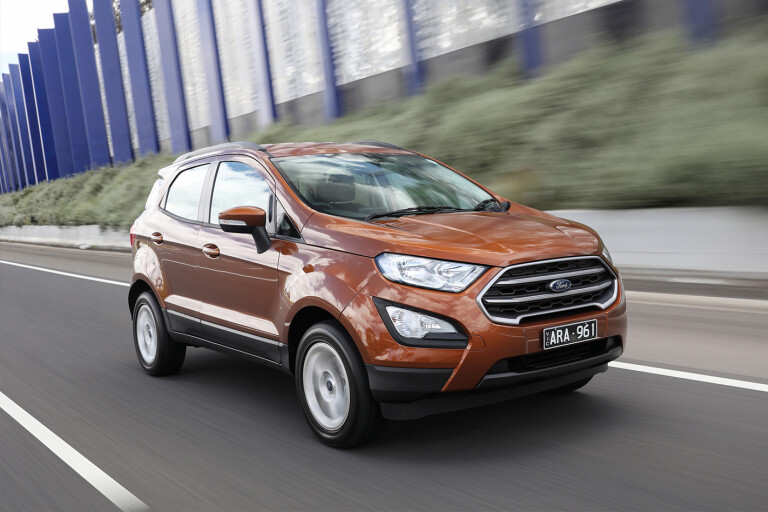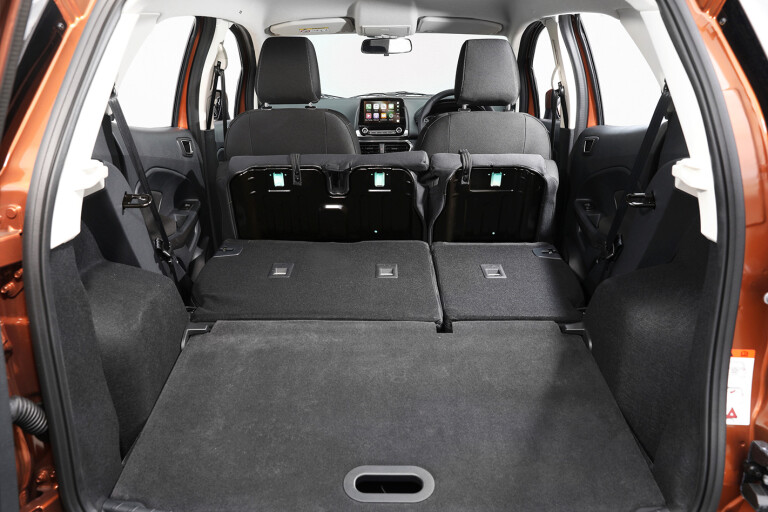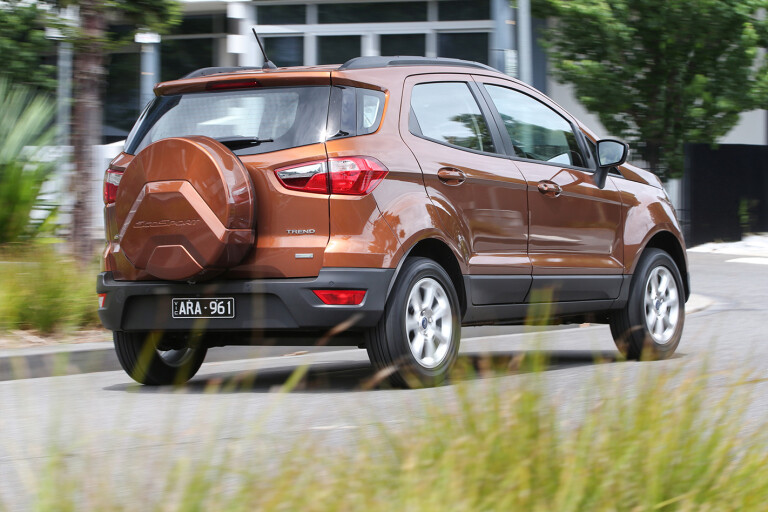
The Ford EcoSport has just undergone its most significant makeover since its launch in Australia in late 2013.
TELL ME ABOUT THIS CAR
This update brings the looks of the Ford EcoSport in line with the other “E”-badged SUVs in the US car maker’s growing Australian showroom – the Escape small SUV, the Everest large SUV, and, when it arrives midway through next year, the Endura midsizer.
Significantly, the update also marks the end of Ford’s troubled Powershift dual-clutch automatic transmission that’s the subject of a class action from disgruntled EcoSport, Fiesta and Focus owners who claim the gearbox did not perform as it should have. Instead, the car maker has reverted to a more traditional torque converter six-speed automatic transmission that, as a downside, makes the fresh-faced Ford EcoSport less fuel-efficient than the one it replaces.
Ford has also used this facelift as an opportunity to drop the six-speed manual transmission option from the line-up; almost no one bought it anyway, the company said.

STRENGTHS
- It looks a whole lot better than the pre-facelift car. The visual improvement made by placing the Ford SUV family face on the EcoSport has given it a huge lift, as have more stylish tail-lights.
- It’s much better to sit in. The interior has had a major makeover with more comfy seats that disguises the EcoSport’s built-down-to-a-price cheapness a little better than before. The highlight, though, is an eight-inch touchscreen rising like a tombstone off the top of the dashboard that includes the latest version of Sync, Ford’s multimedia interface that allows you to use your voice to do things such as set the aircon temperature or tune the radio.
- There’s now a centre armrest in between the front two seats. More noticeable on a long trip, but the flip-up lid also provides some welcome discreet storage space.

- There are two USB ports on the centre console. Given how mobile, figuratively speaking, one of the target buying groups is for this car – young people investing in their first showroom-shiny ride – it’s an important addition.
- A reversing camera with reversing sensors is now standard across the EcoSport range.
- There’s a 12-volt charging point tucked away beside the rear right passenger seat.
- The turbocharged 1.0-litre three-cylinder engine under the EcoSport’s more sculpted bonnet (notice it now has a power bulge?) is a willing little unit that is way better than the non-turbo 1.5-litre three-cylinder engine used to power the entry-level EcoSport Ambiente. The smaller engine’s peak torque packs a bigger number, and over a much wider rev range, meaning it is better to drive in stop-start city traffic.

- The Ecosport Trend carries a full-size spare tyre with a matching 16-inch alloy wheel. It hangs off the rear door.
- It’s roomier than it looks inside. There’s plenty of front-seat space for the driver, with good adjustment behind the wheel.
- Even the back seat has decent room for two passengers. Though the short seatbacks and small, skinny headrests make life a bit less comfortable for taller passengers. The middle rear is best occupied by the very low centre armrest that features a pair of cupholders.
- The 60:40 rear seat folds down to provide up to 1178 litres of cargo space. You flip the seat base forward, and then recline the seatback forward to create a flat space.

WEAKNESSES
- It costs more than before. The cheapest EcoSport Trend pre-facelift was the $22,290 version fitted with a six-speed manual gearbox. Now that the manual has gone, the cheapest Ecosport Trend costs $24,490 with the six-speed automatic transmission, an extra $200 over the auto-equipped version it replaces.
- Safety isn’t class-leading. Other cars in this class have access to autonomous emergency braking, but the EcoSport misses out. Importantly, too, it carries over a five-year-old five-star crash-test rating – in an era where a brand new car without AEB today will get four or three stars.
- The steering is slow. You won’t notice this driving along the road, but get into a car park or a tight laneway that needs a lot of wheel-to-wheel lock on, and you’ll notice the EcoSport takes more hands on the steering wheel than some other cars on the market.

- It has a side-opening tailgate that is optimised for left-hand drive applications. This is strange, as the EcoSport is built in India, a right-hand-drive market. The way it swings also makes it difficult to open if the car behind parks too close and doesn’t leave enough space.
- From midway through next year Ford will replace the EcoSport’s full-size spare wheel with a tyre inflation kit, meaning that if you get a puncture and use it, you’ll have to drive slowly and replace the tyre as soon as possible because the goo that fills the tyre pretty much spells the end for it.
- It’s slightly less fuel-efficient than before. The change from the troubled Powershift dual-clutch auto to the traditional single-clutch torque converter has upped fuel use by 0.2L/100km to 6.7L/100km.

- The front passenger seat sits way too high. You feel you’re sitting above everyone else in the EcoSport.
- The turbo rush of torque will have you chirping a front wheel if you pin the throttle to the firewall. The engine only makes 92kW and 170Nm, but with peak torque arriving not far off idle, it can give you a surprise, especially while cornering.
ANY OTHER CARS I SHOULD CONSIDER?
The biggest threat to the Ford EcoSport Trend is the Mazda CX-3 Maxx, which starts from $22,890. It’s a much more advanced car, with a 2.0-litre engine with an idle-stop function, and automatic emergency braking, and sells in big numbers.
Outselling it, though, is the Mitsubishi ASX, which trades on space (it’s based on the larger, but old Outlander platform) and a sharp $25,000, but like the EcoSport it lacks AEB. Other big sellers in the segment include the Honda HR-V and the recently facelifted Nissan Qashqai.
COMMENTS